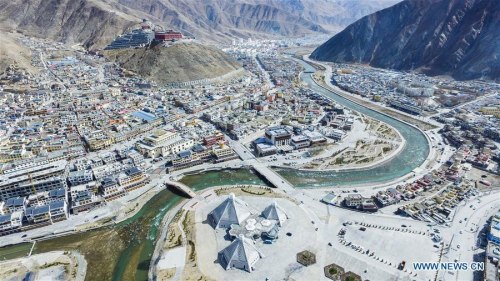
Photo taken on April 11, 2016 shows part of the Yushu Tibetan Autonomous Prefecture in northwest China's Qinghai Province. Yushu has shown a new look after it completed the reconstruction work after the magnitude-7.1 earthquake six years ago on April 14, 2010. (Photo: Xinhua/Wu Gang)
Just over half a decade ago, Yushu Tibet Astomous Prefecture was hit by a catastrophic earthquake that left nearly 3,000 people dead or missing, and completely flattened the prefecture's capital of Gyegu.
Thanks to a successful reconstruction project in Yushu, northwest China's Qinghai Province, it's priorities have shifted and its sights are now set on breathing new life into the local economy.
As a new life unfolds, however, the scars left by the quake are still fresh.
During a poetry reading to commemorate the April 14, 2010 earthquake on Wednesday, Tseji Khadro, 13, struggled to control her emotions when she heard the piece, "My mother, you're the flower in my heart."
Tseji Khadro lost her mother in the quake. "But I wouldn't cry in front of my dad. He has done so much for our family without mum to support him."
The whole of Yushu had to rebuild their lives after the quake left their prefecture in tatters.
Amid the rubble and debris, however, there was a glimmer of hope; tourism. The prefecture realized that it could not only help its residents rebuild their lives, but it could rebuild its economy, too.
The tourism bureau quickly realized that the highland's rivers and pastures could be promoted as the perfect location for tourists in search of respite.
The bureau arranged promotional events in 12 Chinese cities and Nepal last year and with WiFi set to cover the whole of the prefecture by the end of this year, Yushu is open for business.
At 4,000 meters above sea level, Yushu is home to two state-level nature reserves, Sanjiangyuan, the cradle of the Yangtze, Yellow and Lancang rivers; and Hol Xil Nature Reserve, home to several species of endangered wildlife, including Tibetan antelopes.
The tourism bureau has plans for trips circling the Tongtian and Lancang rivers; excursions along the National Highway 109 that runs along the edge of Hol Xil; and tours of the route travelled by Princess Wencheng of the Tang Dynasty on her way to meet her Tibetan husband some 1,400 years ago.
The hunger for commercial benefits, however, has not been at the expense of the fragile eco-system of "Asia's water tower," Sanjiangyuan.
The Sanjiangyuan Area will be made into a 123,100 square-kilometer national park in five years, which will help to protect and manage its natural resources and wildlife. Many tourism and educational projects will be limited to the edges of the park, to minimize any impact from human activity.
Bicycles, too, are being promoted in this green future of Yushu. The prefecture is keen to avoid the traffic woes infecting so many of China's big cities.
"We hope to encourage locals and tourists alike to choose this more preferred mode of transportation," said Cai Chengyong, Party chief of Yushu.


















































